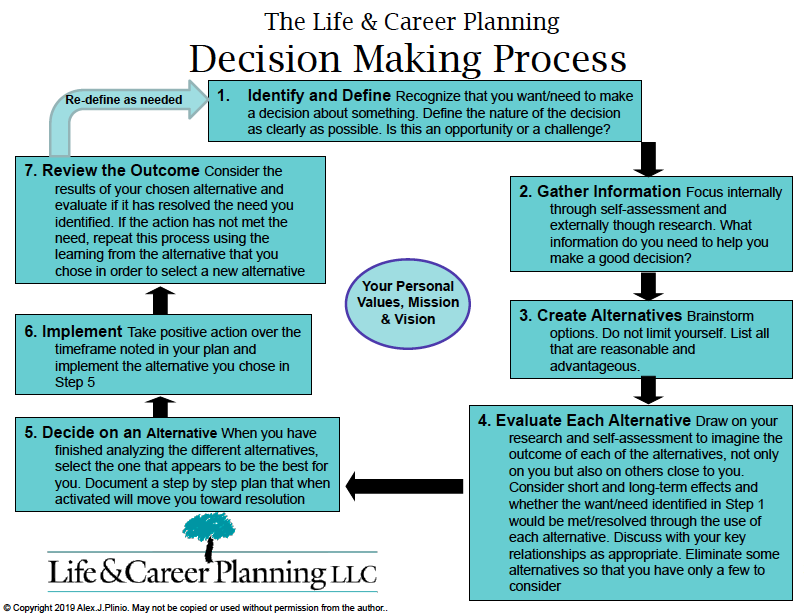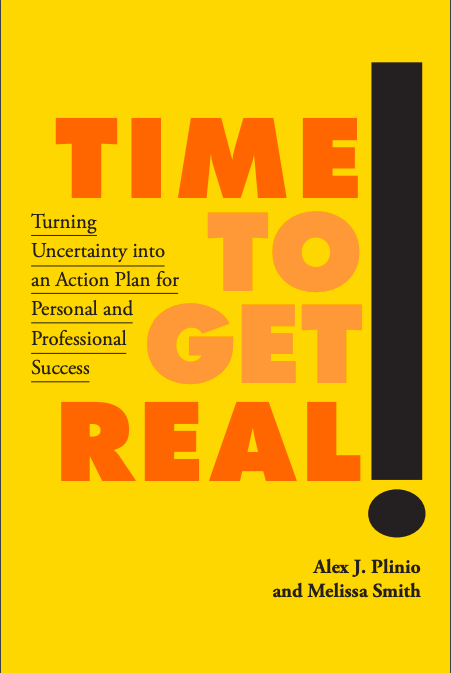We all make decisions. They may be easy or difficult. Some don’t require very much thought but others can impact our life, our career, or other individuals who are important to us. For those decisions that have great meaning for our life and our work, it’s important to do the best possible job that we can in reaching conclusions that will be to our benefit.
At Life and Career Planning, we developed a decision-making process based on research of numerous decision-making models. Below is a graphic depiction of the process. Its application is not for the easy or day-to-day decisions we all make. We suggest using it when a serious life or career problem or opportunity arises. You will note that to make the best decision possible, your personal values, mission, and vision must be central to the decision-making process. Review the model and then review the case study we provide as an example.
Here is an example of how to use the Decision-Making Process.
Case Study:
1. Identify and Define Cedric is a very experienced and knowledgeable technology executive. He has been working for his company’s CEO for just over a year. He is upset and frustrated because the CEO, who is experienced in technology but not as much as Cedric, continually pushes back on Cedric when Cedric is taking independent action. The CEO wants to control a broad array of decision-making as applied in the technology arena. He seems to do it because he likes the field, rather than because it is necessary to get the desired results. Cedric likes the company and his position in it except for the fact that he and the CEO clash more often than not over Cedric’s independent role and the decisions he is making.
2. Gather Information Cedric needs to spend time in self-assessment and reflection regarding his frustration with his boss’ micromanagement. He can also do some research about the technology job market to understand the viability of changing jobs.
3. Create Alternatives
Cedric can just continue to put up with the boss’ behavior and make an effort to not let it bother him so much
Cedric can speak with this boss and let him know that he is frustrated with the micromanagement and suggest a period of time that the boss lets Cedric make the technology decisions and see if the boss can become comfortable with that arrangement
Cedric can go to the head of human resources (HR) and see if they can set up a meeting with the boss to discuss the micromanagement. Maybe HR can have some influence
Cedric can look for a similar position in another organization
4. Evaluate Each Alternative
Put up with the behavior: Cedric is feeling frustrated and undervalued and this is demotivating. This is tolerable in the short run but in the long run, Cedric can’t live with that level of stress and frustration. This is not a viable option for Cedric
Speak with the boss: This risk here is that the boss may reject Cedric’s request to let him make the technology decisions and Cedric has now potentially angered the boss and his career situation is unresolved. On the other hand, the boss may be unaware of how this is impacting Cedric and may be willing to back off and let Cedric do his job. This seems like a viable alternative for Cedric
Go to HR: While it might be helpful to have HR intervene with the boss, it also could anger the boss that Cedric didn’t address the issues directly with the boss. Cedric is a senior executive and should attempt to manage this himself first. This is not a first-choice alternative
Look for a new job: There are many unknowns when changing jobs – Cedric might have to move, there is no guarantee that his relationship with a new boss would be a good one, and changing jobs may increase his commute. This alternative is most likely a last resort since Cedric should ask for what he wants where he is before going elsewhere
5. Decide on an Alternative
Cedric decides to have a conversation with his boss. He prepares for the conversation by discussing the issue in-depth with a trusted colleague in another organization and plans a strategy for the discussion.
6. Implement
Cedric makes a late afternoon appointment to meet with this boss. He has practiced how he will present the issue to his boss. Although he feels some anxiety, he calmly makes his presentation and suggests that the boss allow him to make all the technology decisions for 60 days, and then they will have a follow-up meeting to debrief and agree on how to proceed.
7. Review the Outcome
Cedric’s boss has been unaware of how his micromanaging has impacted Cedric. The boss agrees to Cedric’s 60-day proposal. Cedric will need to revisit this step 7 of the Decision-Making Process after the 60-day period is over. If Cedric is happy with the outcome, he has accomplished his desired outcome. If the boss reverts to his micromanaging ways, Cedric will need to repeat the process using the learning from the first alternative he chose and choose a different alternative.
For those decisions that have great meaning for our life and our work, it’s important to do the best possible job that we can in reaching conclusions that will be to our benefit.
Making better decisions is certainly important in one’s life as well as career. Of course, there is no more important decision than to determine your life’s vision, where it is that you would like to arrive and be the happiest person you can be in both your life and career. If you can do that, you will place yourself way ahead of the competition.
In our book Time To Get Real!, we provide the reader with a market and time-tested guide to help them lead an intentional life. The guide is the Life and Career Planning Model© which helps you take control and directs you through a strategic planning process leading to actions that result in personal and professional success.
The Life and Career Planning Model© life and the Decision-Making Process described above are tools that can move you forward in a positive direction. The Life and Career Planning Model© has been used in our coaching of individuals across all age groups. It works!
To buy the book, click here. Our book is rated 4.5 stars on Amazon.
We recommend that in addition to reading our book Time To Get Real! and working through the Life and Career Planning Model© that it provides, consider some amount of personal coaching that can help you to discern and activate your life’s vision and move you toward the best life and career that you deserve. Our coaching processes and fees are both flexible to accommodate a broad spectrum of individuals. All Life and Career Planning LLC coaches are experienced and certified in the Life and Career Planning Model© and serve as your accountability partner as you read each chapter of the book and capture your thoughts in the interactive exercises. To inquire about working with a coach, click here.



